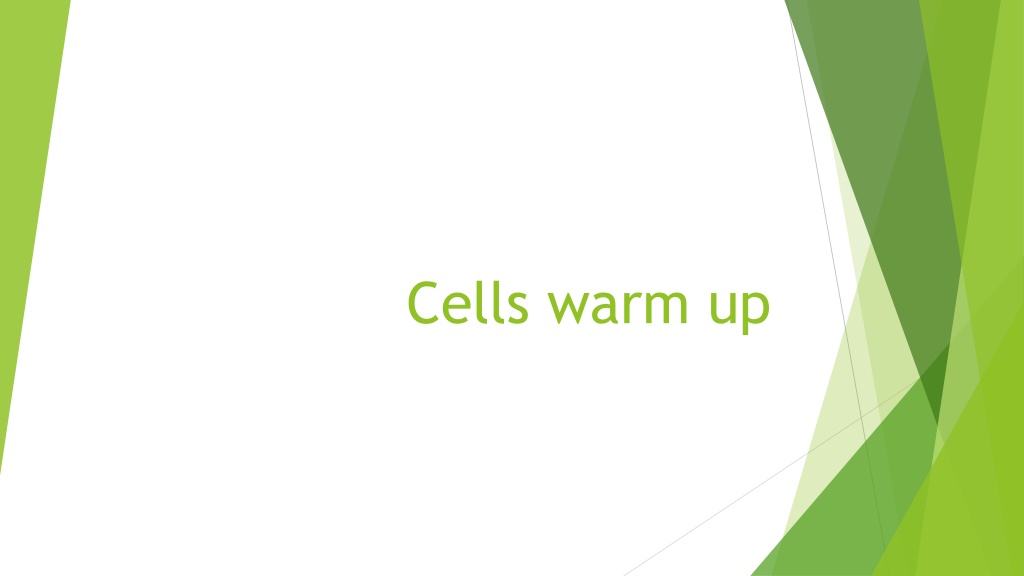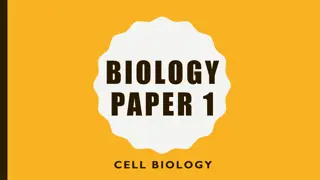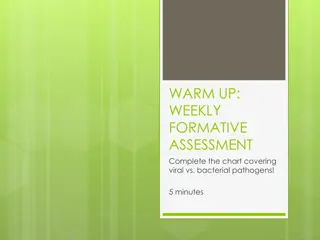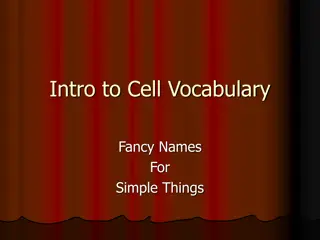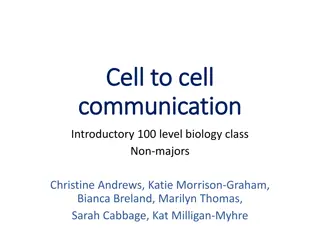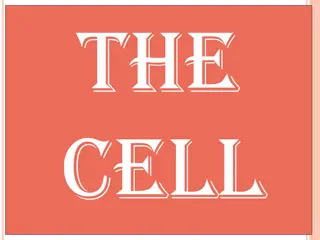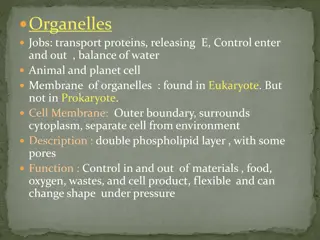Exploring Cell Biology Through Daily Warm-Up Questions
Explore the world of cell biology with a series of daily warm-up questions covering topics such as the characteristics of living things, cell structures, organelle functions, and differences between plant and animal cells. Engage in learning key concepts in a concise and interactive format.
Download Presentation

Please find below an Image/Link to download the presentation.
The content on the website is provided AS IS for your information and personal use only. It may not be sold, licensed, or shared on other websites without obtaining consent from the author. Download presentation by click this link. If you encounter any issues during the download, it is possible that the publisher has removed the file from their server.
E N D
Presentation Transcript
Warm up 09/26/16 1. What is the difference between living and non living things? 2. All the living things are made of 3. How many types of cells are there?
Warm up 09/27/16 1. What characteristics of living things is represented by a puffball releasing millions of spores? a)reproduction c)organization b)development d)use of energy A. What gas most of the organisms need to intake to release the energy from food? a)carbon dioxide b)water vapors c)oxygen d) hydrogen
Warm up 09/28/16 1. Animal cell is different from plant cell because it lacks a] mitochondria b] vacuole c]chloroplast d] ribosomes 2.What is the name of scientist who observed the living organisms under microscope for the first time? a] Robert Hooke b] Schwann c} Antoine van Levenhoek c] Virchow
Warm up 09/29/16 Bacteria and other germs cannot enter the cell because cell membrane blocks them as membrane is A] too thick b] folded C] told to do so d] semi permeable Sam want to grow muscular in order for that to happen which organelle has to work harder A] mitochondria b] ribosomes C] ER D] VACOULE
Warm up 09/30/16 Which of the following organelle is part of bacterial cell? A] mitochondria b] nucleus C] cell wall d] lysosomes What structure/organelle in the cell allows only certain thing to pass in and out? A] cell wall b] cell membrane C] nucleus d] golgi bodies
Warm up 10/03/16 Draw a Venn diagram showing the similarities and differences between plant cell and animal cell. WORD BANK: nucleus, E.R, Golgi bodies, cytoplasm, Chloroplast, cell membrane, cell wall, lysosomes, central vacuole, mitochondria, ribosomes. SHAPE( rectangular, circle)
Warm up 10/04/16 1. A Cell needs to send some proteins to a friend cell. which organelle will help? A] E.R. B] golgi bodies C] ribosomes d] vacuoles 2. A cell feels energy deprived. What organelle might not be working properly? a] ribosomes b] nucleus c] chloroplast d] mitochondria
Warm up 10/05/16 Imagine a new student(happens to be your friend) has just joined your class and he/she missed the lecture on cell theory. Write a paragraph for that student providing all the information on cell theory so that they can pass the upcoming quiz.
Warm up 10/06/16 Pick the word that does not belong to the group. 1. A]mitochondria b] cytoplasm c]chloroplast d] vacuole 2 a] amoeba b] mushroom c] rose d] bacteria
Warm up10/7/16 GIVE ME THE SIMILARITIES AN DIFFERENCES BETWEEN PLANT AND ANIMAL CELLS. WHAT IA CELL THEORY? WHAT IS CELLULAR RESPIRATION?
Warm up 10/11/16 This organelle is the site of cellular respiration A] ribosomes b] mitochondria C] chloroplast d] lysosomes this organelles is extra covering present only in plant cells A] cell membrane b] chloroplast C] central vacuole D] cell wall
Warm up 10/12/16 1. What are the differences between photosynthesis and cellular respiration? 2. Which process breaks down food with the help of oxygen to release energy?. a] cellular respiration b] photosynthesis 3. Which process converts light energy into chemical energy? a] cellular respiration b] photosynthesis
WARM UP 10/13/16 WHAT ARE REACTANTS FOR PHOTOSYNTHESIS? A] SUNLIGHT, OXYGEN, WATER B] SUNLIGHT, WATER , CARBON DIOXIDE C] SUNLIGHT,GLUCOSE, WATER D] SUNLIGHT, GLUCOSE, CARBON DIOXIDE WHAT ARE THE PRODUCTS OF CELLULAR RESPIRATION? A] OXYGEN, ENERGY,WATER B] ENERGY,WATER,GLUCOSE C] ENERGY,CARBON DIOXIDE,WATER D] ENERGY,WATER,CARBON MONOXIDE
WARM UP 10/14/16 What occurs when the number of molecules of a substance is equal in two areas? A] fermentation b] metabolism C] cellular respiration d] equilibrium Which formula is an example of organic molecule? A] H2o B] NO2 C] O2 D] C6H12O6
Warm up 10/17/16 In plants water moves from roots to stem and then leaves through a chain of cells. This is an example of a] diffusion b] osmosis Oxygen from lungs is absorbed into the blood vessels in our body. This is an example of .. a] diffusion b] osmosis Passive transport does not need energy because a] particles are moving from low to high concentration b] particles are moving from high to low concentration
Warm up 10/18/16 Amoeba eating paramecium is an example of A] exocytosis b] endocytosis Kidney filtering blood is an example of .. A] active transport b] passive transport Perfume spreading from one corner of room to another A]osmosis b] diffusion
Warm up 19/10/16 Starch present in potato comes from . A]cellular respiration b] reproduction c] photosynthesis d] homeostasis A cell has 40% water and is placed into a solution that is 20% water . The cell and the solution will reach equilibrium when both have .. Water A] 20% b] 40% c] 25% d] 30% Sam fractured his leg. He needs division to heal. A] mitosis b] meiosis
WARM UP 10/20/16 1.WHERE DOES THE PROCESS OF PHOTOSYNTHESIS TAKES PLACE IN A CELL? A]MITOCHONDRIA B]CHLOROPLAST C] CYTOPLASM D] GOLGI BODIES 2. WHAT PROCESSES NEED PROTEIN CHANNELS TO MOVE PARTICLES THROUGH CELL MEMBRANE? A] ACTIVE AND PASSIVE TRANSPORT B]ACTIVE TRANSPORT C]ACTIVE TRANSPORT AND FACILITATED FIFFUSION 3.WHAT PROCESS NEEDS ENERGY? A] DIFFUSSION B] FACILITATED DIFFUSION C] ENDOCYTOSIS
Warm up 10/21/16 Name the two types of passive transport. Name the two types of active transport. Give one difference and one similarity between active transport and facilitated diffusion.
WARM UP 10/24/16 DRAW A HILL DIAGRAM FOR CELL TRANSPORT AND LABEL IT USING THESE WORD: 1. ACTIVE TRANSPORT 2. PASSIVE TRANSPORT 3. LOW TO HIGH 4. HIGH TO LOW 5. ENERGY USED 6. NO ENERGY USED
Warm up 10/25/16 What is the main function for cell membrane? A] protection b] support c] allows transport If our muscles need more energy we will need more ..in our muscles A] ribosomes b] golgi bodies c] mitochondria What two transports need protein channels? a] active and passive b] active and facilitated diffusion C]active and diffusion
Warm up 10/26/16 Name the process on the right. Movement of particles in active transport is from to concentration. Movement of particles in passive transport is from to concentration. Movement of particles in facilitated diffusion is from to concentration.
Warm up 10/27/16 All living reactions in living things take place in what kind of solutions? A] proteins b] gas C] water d] solid Where do most of cell s life processes occur? A] nucleus b]cell wall C]organ d] cytoplasm Why is a virus not considered a living thing? A] it has a cell wall b] it has a hereditary material C] it cannot multiply d] it has no organelles
Warm up 10/28/16 What are the differences and similarities between diffusion and osmosis? What is endocytosis and exocytosis? What is the difference between the cell wall of plants and cell wall of fungi?
